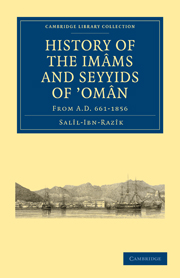Book contents
- Frontmatter
- Contents
- Editor's Preface
- Introduction and Analysis
- Editions of Books quoted by the Editor
- Errata
- List of Imâms, Seyyids, etc., with references to the pages where they are treated of, q.v.
- Author's Title and Preface
- Beginning of the History
- Appendix A On the Title of “Imâm”
- Appendix B The Ibâdhiyah
- Appendix C Murder of the Khalîfah 'Aly-ibn-Abi-Tâlib
- Appendix D Dynasty of the Âl-Bû-Sa'îd
- Postscript: On the Islands of el-Kais and el-Kishm, and the situation of Sîrâf in the Persian Gulf
- Index
Appendix A - On the Title of “Imâm”
Published online by Cambridge University Press: 07 September 2011
- Frontmatter
- Contents
- Editor's Preface
- Introduction and Analysis
- Editions of Books quoted by the Editor
- Errata
- List of Imâms, Seyyids, etc., with references to the pages where they are treated of, q.v.
- Author's Title and Preface
- Beginning of the History
- Appendix A On the Title of “Imâm”
- Appendix B The Ibâdhiyah
- Appendix C Murder of the Khalîfah 'Aly-ibn-Abi-Tâlib
- Appendix D Dynasty of the Âl-Bû-Sa'îd
- Postscript: On the Islands of el-Kais and el-Kishm, and the situation of Sîrâf in the Persian Gulf
- Index
Summary
The word “Imâm” comes from an Arabic root signifying to aim at, to follow after, most of the derivatives of which partake, more or less, of that idea. Thus Imâm means, primarily, an exemplar, or one whose example ought to be imitated. It is applied in that sense, κατ εψōΞην, to Muhammad, as being the leader and head of the Muslims in civil and religious matters, and also to the Khalîfahs, or legitimate Successors, as his representatives in both capacities. It is also given—in its religious import only—to the heads of the four orthodox sects, namely, the el-Hanafy, esh-Shâfa'y, el-Mâliky, and el-Hánbaly; and, in a more restricted sense still, to the ordinary functionary of a mosque who leads in the daily prayers of the congregation—an office usually conferred on individuals of reputed piety, who are removable by the Nâzirs, or wardens, and who, with their employment and salary, lose the title also.
The term is used in the Kurân to indicate the Book, or Scriptures, or record of a people; also, to designate a teacher of religion. Hence, most probably, its adoption by the Muslims in the latter sense. “When the Lord tried Abraham with certain words, which he fulfilled, He said, I have made thee an Imâm to the people.” Again, referring to Abraham, Isaac, and Jacob, “We have made them Imams that they may direct others at our command.” And, again, “We delivered to Moses the Book, therefore be not in doubt of his reception thereof, and we ordained it to be a guide unto the children of Israel. And we appointed some of them to be Imams to direct the people according to our command.”
- Type
- Chapter
- Information
- History of the Imâms and Seyyids of ‘OmânFrom A.D. 661–1856, pp. 373 - 384Publisher: Cambridge University PressPrint publication year: 2010First published in: 1871

